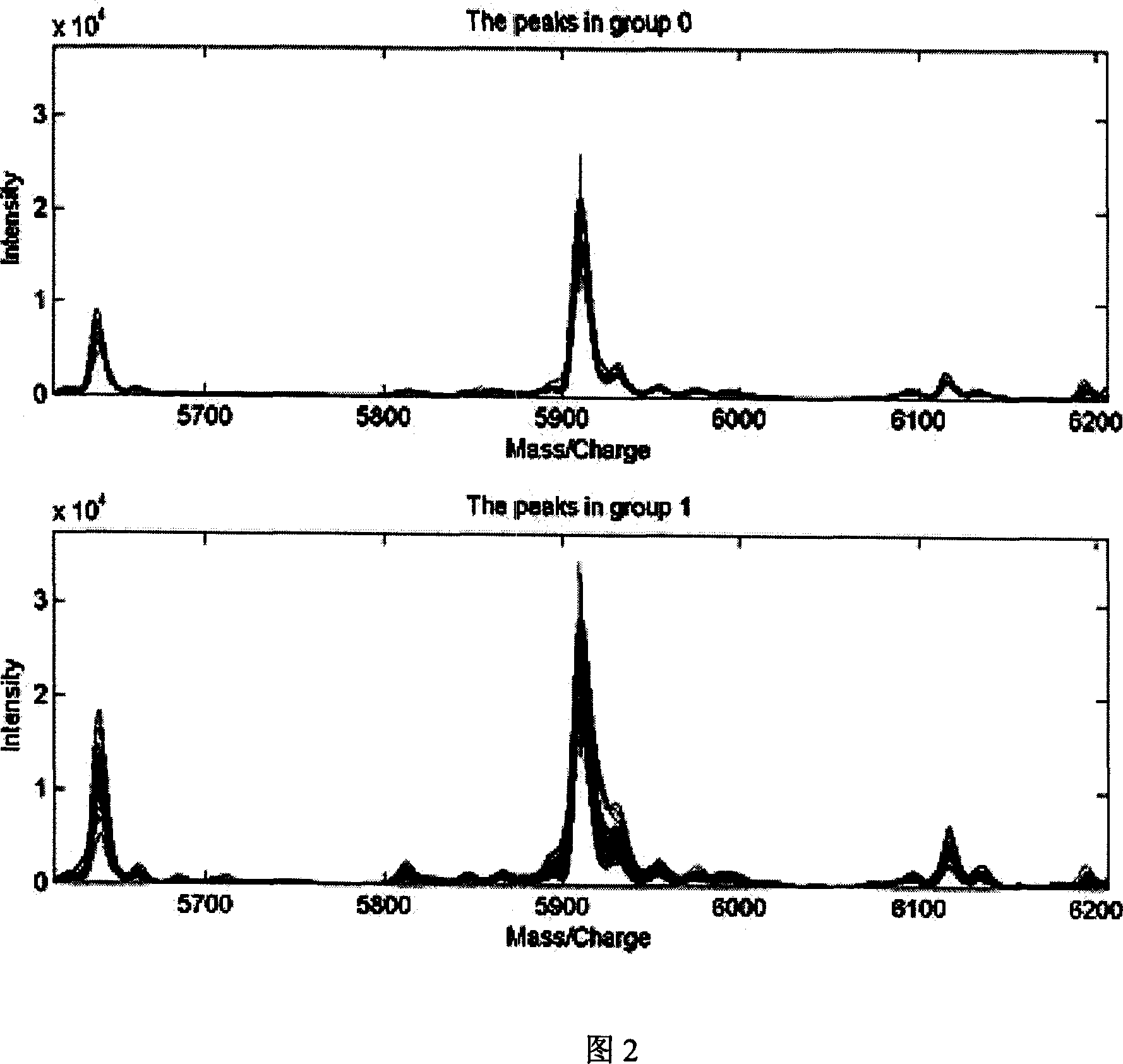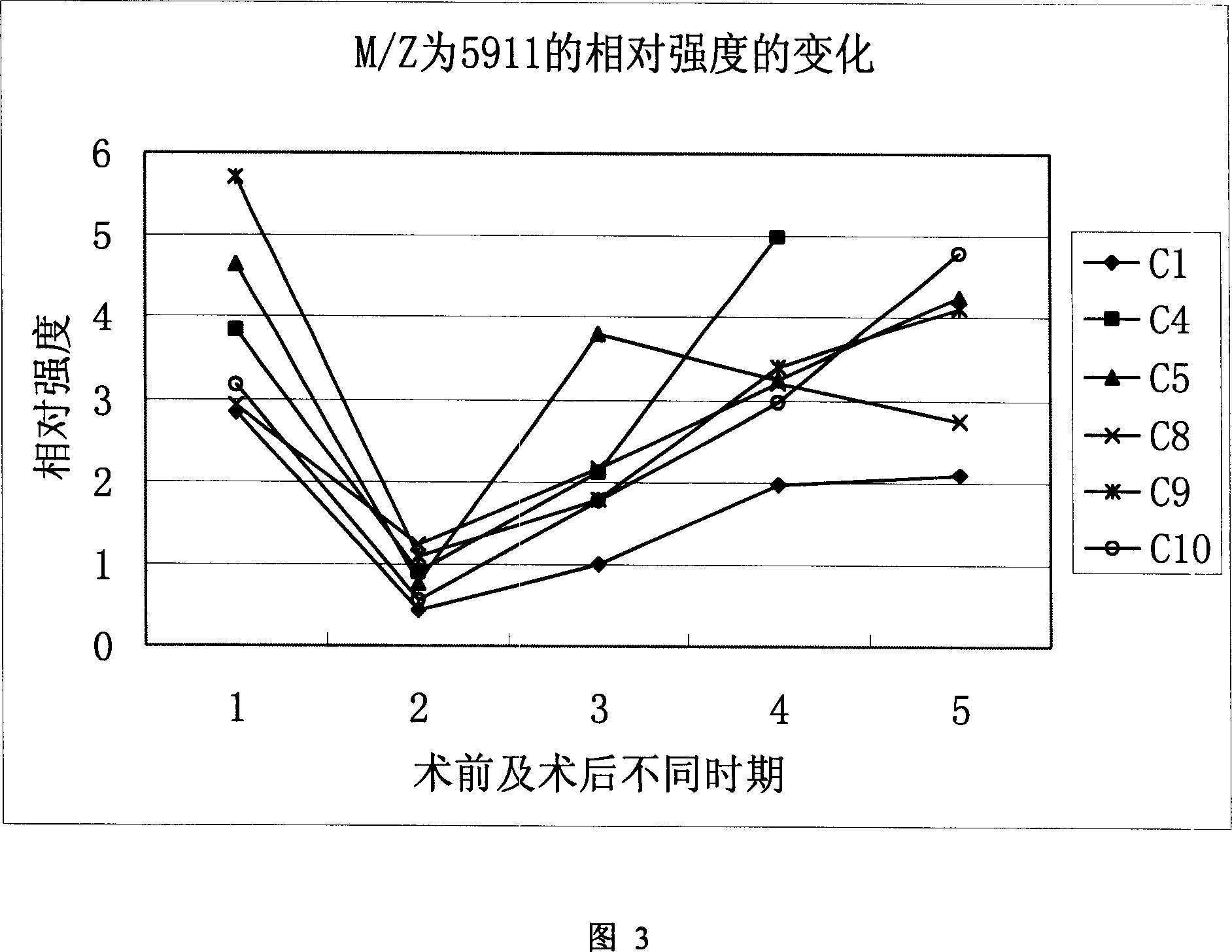Application of polypeptide tagging object in detecting tumor in large intestine, and monitoring after operation
A technology for large intestine and tumor, applied in the application field of polypeptide markers, can solve the problems of unclear protein function and large research space, and achieve the effect of improving the level of diagnosis and treatment and postoperative survival rate
- Summary
- Abstract
- Description
- Claims
- Application Information
AI Technical Summary
Problems solved by technology
Method used
Image
Examples
Embodiment 1
[0022] Example 1 Identification of colorectal cancer-related proteins
[0023] The sample used for separation is a 1ml serum sample from a patient with colorectal cancer. Serum was initially separated by SPE column (reversed phase, acetonitrile gradient) (monitored by SELDI-TOF-MS for the eluted fraction where the target protein was located), and then enriched by a freeze-dryer. After redissolving, use high-performance liquid chromatography-mass spectrometry (HPLC-MS) to separate and purify (use MALDI-TOF-MS to monitor the elution component where the target protein is located), and further digest the target elution component with trypsin. Several of the fragments were sequenced by LC / MS / MS, the amino acid sequence was determined and submitted to MASCOT (MatrixScience, www.matrixscience.com) to determine the source of the target protein peak. After determining the primary sequence of the protein, purchase the corresponding antibody, and use the antibody to bind to the high-ex...
Embodiment 2
[0031] Example 2 Differential expression of colorectal cancer-associated polypeptide 1 in colorectal cancer and control samples
[0032] Serum samples from 55 cases of colorectal cancer and 92 healthy people were combined with H4 chip and detected by SELDI mass spectrometer. Further use the CM10 chip to detect 124 cases of colorectal cancer samples and 46 healthy controls to verify the difference of colorectal cancer-related polypeptide 1
[0033] 1 Chip pretreatment
[0034] l Put the chip into the 96-well protein chip working bracket Bio-processor, and write down the chip number.
[0035] lAdd 200μl Binding Buffer corresponding to the chip to each well:
[0036] H4: 20mM HEPES (pH=7.4)
[0037] CM10: 50mM sodium acetate (pH=4.0)
[0038] l Oscillate on a shaker (600rpm, room temperature) for 5 minutes to fully balance, remove the liquid, and repeat the balance once.
[0039] 2 Pretreatment of serum
[0040] l Melt the serum slowly on an ice bath (30-60 minutes), and ce...
Embodiment 3
[0058] Example 3 Application of colorectal cancer-associated polypeptide 1 in postoperative detection and prognosis estimation of colorectal cancer
[0059] 1. Materials and Methods
[0060] 1.1 Materials
[0061] Serum samples from 10 patients with colorectal cancer before operation, 3 months after operation, 6 months after operation, 12 months after operation, and 18 months after operation.
[0062] Protein Chip Selection: H4 Hydrophobic Surface Chip.
[0063] 1.2 Experimental method
[0064] 1.2.1 According to the standard of diagnosis and treatment of colorectal cancer, the serum CEA, hepatobiliary color Doppler ultrasound or CT, bone ECT, chest X-ray, and electronic colonoscopy were reexamined before and after 3 months, 6 months, 12 months, 18 months, and 24 months. Establish a database of clinical and pathological data, postoperative treatment and follow-up data of colorectal cancer based on ACCESS.
[0065] 1.2.2 The experimental procedure of serum protein mass spec...
PUM
 Login to View More
Login to View More Abstract
Description
Claims
Application Information
 Login to View More
Login to View More - R&D
- Intellectual Property
- Life Sciences
- Materials
- Tech Scout
- Unparalleled Data Quality
- Higher Quality Content
- 60% Fewer Hallucinations
Browse by: Latest US Patents, China's latest patents, Technical Efficacy Thesaurus, Application Domain, Technology Topic, Popular Technical Reports.
© 2025 PatSnap. All rights reserved.Legal|Privacy policy|Modern Slavery Act Transparency Statement|Sitemap|About US| Contact US: help@patsnap.com



